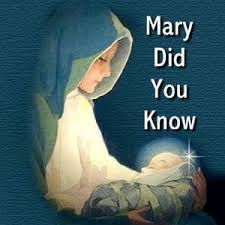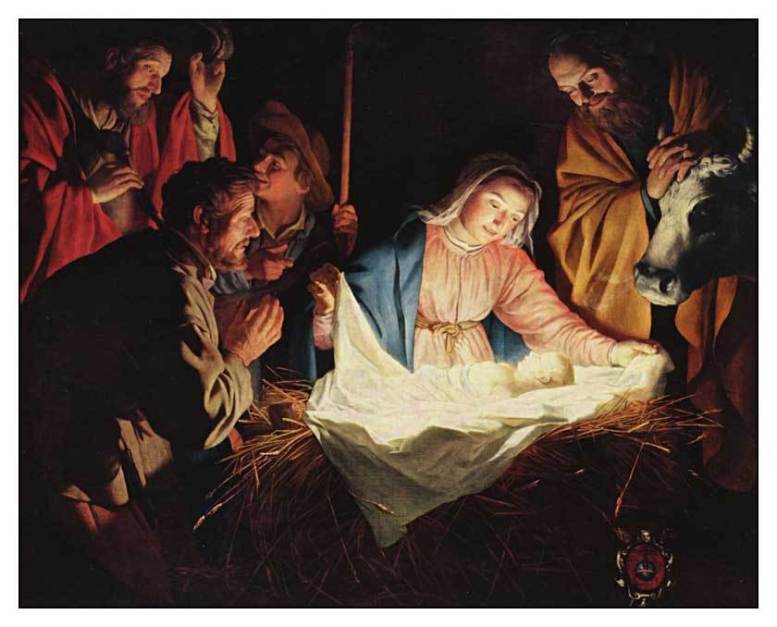What Did Mary Really Know?
 Every year during the Christmas Season, there are articles published that are critical of the song, Mary Did You Know. As expected, in early December, Fr. Robert McTeigue, SJ, published an article with the title, “The Problem With ‘Mary Did You Know.’” In the article, Fr. McTeigue criticized the following lyrics: “Did you know that your Baby Boy has come to make you new? This Child that you delivered will soon deliver you.”
Every year during the Christmas Season, there are articles published that are critical of the song, Mary Did You Know. As expected, in early December, Fr. Robert McTeigue, SJ, published an article with the title, “The Problem With ‘Mary Did You Know.’” In the article, Fr. McTeigue criticized the following lyrics: “Did you know that your Baby Boy has come to make you new? This Child that you delivered will soon deliver you.”
Fr. McTeigue’s complaint was that the lyrics imply that Mary was a sinner who needed to be delivered from her sins. This is contrary to Catholic doctrine which states that Mary was preserved free from all stain of original sin from the moment of her immaculate conception, which allowed her to be a pure vessel in which the Son of God could be conceived and born without ever having come into contact with sin.
Another article that was published before Christmas stated that the song implies that Mary was not fully aware that she was the Mother of God. The article went on to say that anyone who is familiar with the Bible knows that Mary possessed knowledge that she was the Mother of God, not only because of the Angel Gabriel’s announcement (Luke 1:26-56), but also because of her “song of praise” — known as “The Magnificat” — which indicated that she was aware of her role in the salvation of mankind. Here are the first two sentences of the Magnificat:
My soul magnifies the Lord, and my spirit rejoices in God my Savior, for he has looked with favor on the lowliness of his handmaid. For behold, from henceforth all generations shall call me blessed; for he who is mighty, has done great things for me and holy is his name. (Luke 1:46-49)
Whenever I read anything about the life of Mary, I think about a book that I read in the early 1980s, while I was in law school. The title of the book was, The Life of The Blessed Virgin Mary. The content for the book was taken from the recorded visions of the well-known 19th-century Catholic mystic, Venerable Anne Catherine Emmerich (1774 – 1824).
According to the Modern Catholic Dictionary, a “mystic” is a person whose soul has been elevated by God to a supernatural state in which God is known in a way that no human effort or exertion could ever succeed in producing. A mystic is given certain insights that are far beyond ordinary human knowledge.
It is believed that because of a special grace that she received from God, Emmerich was granted visions that allowed her to see what the Blessed Mother experienced before, during, and after the birth of the Son of God.
One of Emmerich’s visions revealed part of the Holy Family’s journey after the birth of Christ, when they traveled from Bethlehem to Egypt to escape from King Herod. During their journey, the Holy Family stayed overnight at the homes of people who were willing to help them out. Here is one of the visions that was described by Emmerich:
At last I saw the Holy Family follow these animals and pass over a mountain ridge into a wild and lonely region. It was dark, and the way led past a wooded area. In front of this wooded area, at some distance from the path, I saw a poor hut, and not far from it a light hanging in a tree, which could be seen from a long way off, to attract travelers.
This part of the road was sinister: trenches had been dug in it here and there, and there were also trenches all around the hut. Hidden cords were stretched across the good parts of the road, and when touched by travelers rang bells in the hut and brought out its thieving inhabitants to plunder them. This robbers’ hut was not always in the same place. It could be moved about and put up wherever its inhabitants wanted it.
When the Holy Family approached the light hanging in the tree, I saw the leader of the robbers with five of his companions closing around them. At first, they were evilly disposed, but I saw that at the sight of the Infant Jesus a ray, like an arrow, struck the heart of the leader, who ordered his comrades to do no harm to these people. The Blessed Virgin also saw this ray strike the robber’s heart, as she later recounted to Anna the prophetess when she returned.
The robber now led the Holy Family through the dangerous places in the road into his hut. It was night. In the hut was the robber’s wife with some children. The man told his wife of the strange sensation that had come over him at the sight of the Child.
Emmerich then described how the wife of the robber warmed up to the Holy Family and served them some bread with honey. Emmerich then explained what happened after Mary and Joseph were finished eating:
The woman arranged a separate place for the Blessed Virgin, and brought at her request a trough with water for washing the Infant Jesus. She washed the linen for her and dried it at the fire. Mary bathed the Infant Jesus under a cloth.
The man was very much agitated and said to his wife: “This Hebrew child is no ordinary child, he is a holy child. Ask his mother to allow us to wash our leprous little boy in his bath water. Perhaps it will do him good.”
As the woman came up to Mary to ask her this, our Lady told her, before she had said a word, to wash her leprous boy in the bath water. The woman brought her three-year-old son lying in her arms. He was stiff with leprosy and his features could not be seen because of scabs on his skin.
The water in which Jesus had been bathed seemed clearer than it had been before, and as soon as the leprous child was dipped into it, the scales of his leprosy fell off of him to the ground and the child was cleansed.
The woman was beside herself with joy, and tried to embrace Mary and the Infant Jesus, but Mary put out her hand and would not let her touch either herself or Jesus.
Although the Catholic Church began the process to canonize Anne Catherine Emmerich and subsequently declared her to be “Blessed,” the Church has never taken an official position on the authenticity of her visions.
We have no way of knowing whether Emmerich’s visions were from God or were the result of a very creative imagination; however, the visions that I quoted are worth considering because they prompt us to consider what Mary and Joseph were forced to endure on their initial journey from Nazareth to Bethlehem, which was roughly 80 miles, and their subsequent journey (after the birth of Jesus), from Bethlehem to Egypt, which was more than 40 miles.
Because Saint Joseph walked while the Blessed Mother rode a donkey, they would have had to depend on strangers to feed them and provide them with a place to sleep. What happened in the homes where the Holy Family stayed? What special graces were granted to the people in those homes because of their generosity toward the Holy Family? What spiritual and physical miracles did the infant Savior perform in those homes? What did Mary really know at that time about her Son?
I’m looking forward to finding out the answers to those questions when I’m finally able to meet the Holy Family in Heaven.




4 Comments
Greetings to you, Georgette and Harry –
I’m interested in responses to “Mary did you know?” and I ask the same question. So I, too, will be happy to learn directly from her what she DID know, and when and how she knew!
I want to tell you now,what a wonderful daughter you have in Teresa, your youngest. In the two hours she had, she has sent us a delightful and informative account of your whole family! I love it!
Please tell her I congratulate her for her accomplishment in creating your Christmas Message to us! May your 2018 be filled with joy peace and health for your entire family! Love, Sister Roberta
Sister Roberta – I passed your message on to Teresa and she appreciated hearing from you. I hope you have another blessed and productive year in which you are able to share your gifts with the members of your community. Love, Harry
The lyrics are problematic, but I don’t think impossible to reconcile. It is like our response to the question, Did Mary need a savior? See https://www.catholic.com/video/if-mary-was-sinless-why-did-she-need-a-savior In an eternal and universal sense, Mary, like the rest of us needed a saviour, but her salvation was given first at her conception, unlike ours received later. Unlike Eve, however, Mary kept faithful to her savior, as we are called to do. How much did she know is a profound question that I don’t think is fully known by Gabriel’s greeting or Mary’s Magnificat. That David’s descendant would have an eternal throne does not necessarily tell the ancients that He is God himself. That revelation was slowly revealed and may only have been expressed first by doubting Thomas on Divine Mercy Sunday when he said to the risen Christ, “My Lord and my God.”
I am no mystic, but I think that artistic license can allow for interesting accounts of the nativity story, such as the movie by that name or my own play, A Farewell to Bethlehem at http://lincolninpeoria.blogspot.com/2014/11/a-farewell-to-bethlehem.html
Dan – Thanks for your comment. I wasn’t aware that you wrote a play on this topic. Good job. It might be worthwhile publishing the play and offering it to Catholic grade schools to use with their students. I hope you and your family have a blessed, healthy, and prosperous 2018. Take care, Harry